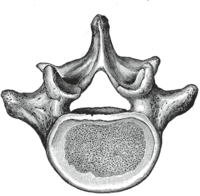Lumbar vertebrae
|
|
Gray93.png
The lumbar vertebrae are the largest segments of the movable part of the vertebral column, and can be distinguished by the absence of a foramen (hole) in the transverse process, and by the absence of facets on the sides of the body.
| Contents |
General characteristics
These are the general characteristics of the first through fourth lumbar vertebrae. The fifth vertebra contain certain peculiarities, which are detailed below.
The body is large, wider from side to side than from before backward, and a little thicker in front than behind. It is flattened or slightly concave above andbelow, concave behind, and deeply constricted in front and at the sides. The pedicles are very strong, directed backward from the upper part of the body; consequently, the inferior vertebral notches are of considerable depth. The laminae are broad, short, and strong; the vertebral foramen is triangular, larger than in the thoracic, but smaller than in the cervical region. The spinous process is thick, broad, and somewhat quadrilateral; it projects backward and ends in a rough, uneven border, thickest below where it is occasionally notched. The superior and inferior articular processes are well-defined, projecting respectively upward and downward from the junctions of pedicles and laminae. The facets on the superior processes are concave, and look backward and medialward; those on the inferior are convex, and are directed forward and lateralward. The former are wider apart than the latter, since in the articulated column the inferior articular processes are embraced by the superior processes of the subjacent vertebra. The transverse processes are long, slender, and horizontal in the upper three lumbar vertebrae; they incline a little upward in the lower two. In the upper three vertebrae they arise from the junctions of the pedicles and laminae, but in the lower two they are set farther forward and spring from the pedicles and posterior parts of the bodies. They are situated in front of the articular processes instead of behind them as in the thoracic vertebrae, and are homologous with the ribs. Of the three tubercles noticed in connection with the transverse processes of the lower thoracic vertebrae, the superior one is connected in the lumbar region with the back part of the superior articular process, and is named the mammillary process; the inferior is situated at the back part of the base of the transverse process, and is called the accessory process.
Peculiar lumbar vertebrae
Fifth lumbar vertebra
The fifth lumbar vertebra is characterized by its body being much deeper in front than behind, which accords with the prominence of the sacrovertebral articulation; by the smaller size of its spinous process; by the wide interval between the inferior articular processes; and by the thickness of its transverse processes, which spring from the body as well as from the pedicles.
All of this copied and pasted from the 1917 Gray's anatomy, which is in the public domain: The Lumbar Vertebrae (http://www.bartleby.com/107/23.html)
External links
- Gray's Anatomy (http://www.bartleby.com/107/): The Lumbar Vertebrae (http://www.bartleby.com/107/23.html) - The 1917 Gray's Anatomy is available via the Bartleby project. It is available with full colour diagrams, and provides an excellent starting point in anatomy, as well as a relatively complete source for gross anatomy.it:Vertebra lombare

